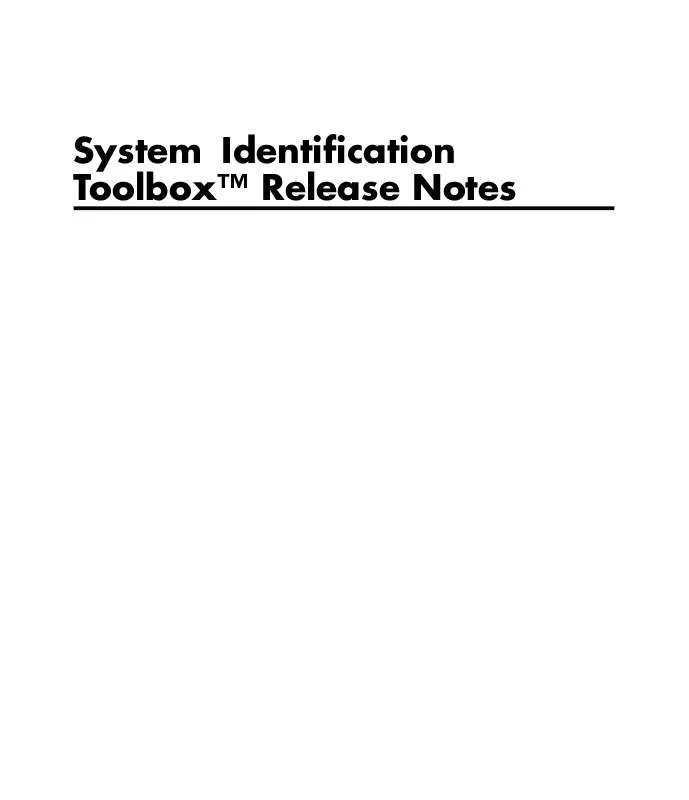User manual THE MATHWORKS SYSTEM IDENTIFICATION TOOLBOX RELEASE NOTES
Lastmanuals offers a socially driven service of sharing, storing and searching manuals related to use of hardware and software : user guide, owner's manual, quick start guide, technical datasheets... DON'T FORGET : ALWAYS READ THE USER GUIDE BEFORE BUYING !!!
If this document matches the user guide, instructions manual or user manual, feature sets, schematics you are looking for, download it now. Lastmanuals provides you a fast and easy access to the user manual THE MATHWORKS SYSTEM IDENTIFICATION TOOLBOX. We hope that this THE MATHWORKS SYSTEM IDENTIFICATION TOOLBOX user guide will be useful to you.
Lastmanuals help download the user guide THE MATHWORKS SYSTEM IDENTIFICATION TOOLBOX.
Manual abstract: user guide THE MATHWORKS SYSTEM IDENTIFICATION TOOLBOXRELEASE NOTES
Detailed instructions for use are in the User's Guide.
[. . . ] System Identification ToolboxTM Release Notes
How to Contact MathWorks
Web Newsgroup www. mathworks. com/contact_TS. html Technical Support
www. mathworks. com comp. soft-sys. matlab suggest@mathworks. com bugs@mathworks. com doc@mathworks. com service@mathworks. com info@mathworks. com
Product enhancement suggestions Bug reports Documentation error reports Order status, license renewals, passcodes Sales, pricing, and general information
508-647-7000 (Phone) 508-647-7001 (Fax) The MathWorks, Inc. 3 Apple Hill Drive Natick, MA 01760-2098
For contact information about worldwide offices, see the MathWorks Web site. System Identification ToolboxTM Release Notes © COPYRIGHT 20032010 by The MathWorks, Inc.
The software described in this document is furnished under a license agreement. The software may be used or copied only under the terms of the license agreement. [. . . ] If you have installed Real-Time Workshop® software, you can generate code from models containing nonlinear ARX and the Hammerstein-Wiener model blocks. However, you cannot generate code when: · Hammerstein-Wiener models use the customnet estimator for input or output nonlinearity. · Nonlinear ARX models use custom regressors or use the customnet or neuralnet nonlinearity estimator. You can access the new System Identification Toolbox blocks from the Simulink Library Browser. For more information about these blocks, see the IDNLARX Model (nonlinear ARX model) and the IDNLHW Model (Hammerstein-Wiener model) block reference pages.
Linearizing Nonlinear Black-Box Models at User-Specified Operating Points
You can now use the linearize command to linearize nonlinear black-box models, including nonlinear ARX and Hammerstein-Wiener models, at specified operating points. Linearization produces a first-order Taylor series approximation of the system about an operating point. An operating point is defined by the set of constant input and state values for the model. If you do not know the operating point, you can use the findop command to compute it from specifications, such as steady-state requirements or values of these quantities at a given time instant from the simulation of the model.
14
Version 7. 2 (R2008a) System Identification ToolboxTM Software
For nonlinear ARX models, if all of the steady-state input and output values are known, you can map these values to the model state values using the data2state command.
linearize replaces lintan and removes the restriction for linearizing models
containing custom regressors or specific nonlinearity estimators, such as
neuralnet and treepartition.
If you have installed Simulink® Control DesignTM software, you can linearize nonlinear ARX and Hammerstein-Wiener models in Simulink after importing them into Simulink. For more information, see: · "Linear Approximation of Nonlinear Black-Box Models" about computing operating points and linearizing models · "Simulating Model Output" about importing nonlinear black-box models into Simulink
Estimating Multiple-Output Models Using Weighted Sum of Least Squares Minimization Criterion
You can now specify a custom weighted trace criterion for minimization when estimating linear and nonlinear black-box models for multiple-output systems. This feature is useful for controlling the relative importance of output channels during the estimation process. The Algorithm property of linear and nonlinear models now provides the Criterion field for choosing the minimization criterion. This new field can have the following values: · det -- (Default) Specify this option to minimize the determinant of the prediction error covariance. This choice leads to maximum likelihood estimates of model parameters. It implicitly uses the inverse of estimated noise variance as the weighting function. This option was already available in previous releases. · trace -- Specify this option to define your own weighing function that controls the relative weights of output signals during the estimation. This criterion minimizes the weighted sum of least square prediction errors. You
15
System Identification ToolboxTM Release Notes
can specify the relative weighting of prediction errors for each output using the new Weighting field of the Algorithm property. By default, Weighting is an identity matrix, which means that all outputs are weighed equally. Set Weighting to a positive semidefinite symmetric matrix. For more information about these new Algorithm fields for linear estimation, see the Algorithm Properties reference page. For more information about Algorithm fields for nonlinear estimation, see the idnlarx and idnlhw reference pages. [. . . ] A new GUI that supports this object is available in the System Identification Toolbox GUI. To learn more about this object, type iddemopr at the MATLAB prompt to run a demo. You can also try the command
m = pem(data, 'p1d')
30
Version 6. 0 (R13SP2) System Identification ToolboxTM Software
Estimation and Validation in Frequency Domain Now Supported
You can now perform estimation and validation using frequency-domain data, such as the following: · Inputs and outputs, entered as frequency-domain data in the iddata object · Frequency-response data from a frequency analyzer Both System Identification Toolbox functions and the graphical user interface (GUI) support this. All estimation, simulation, and validation routines accept frequency-domain data and frequency-response data as inputs, similar to time-domain data. [. . . ]
DISCLAIMER TO DOWNLOAD THE USER GUIDE THE MATHWORKS SYSTEM IDENTIFICATION TOOLBOX Lastmanuals offers a socially driven service of sharing, storing and searching manuals related to use of hardware and software : user guide, owner's manual, quick start guide, technical datasheets...manual THE MATHWORKS SYSTEM IDENTIFICATION TOOLBOX


